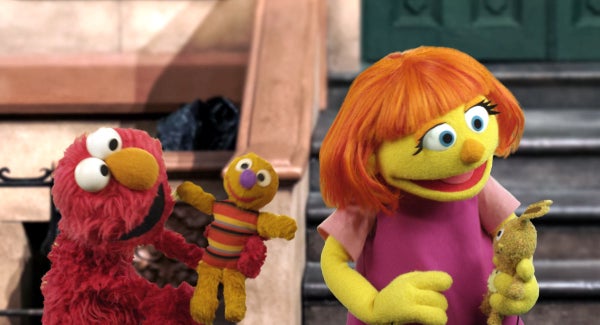
Elmo with Julia
In April of 2017, the children’s television show, Sesame Street, introduced Julia, a muppet with autism. The show’s autism awareness initiative carried the theme: See Amazing in All Children.
Thank you, Sesame Street, for continuing to introduce characters with differing abilities!
As an educator of twenty years, I continue to strive to see the amazing in all children. When reading Kai and Hannah’s stories later in this post, I invite you to see the amazing person each young woman is. Don’t just see their struggles. See all they have to offer our world.
Autism Awareness
For this autism awareness month, let’s first look at a few of the statistics. They will help us understand who autism impacts and the characteristics of those on the autism spectrum.
In 2018, the prevalence of Autism Spectrum Disorder (ASD) was 1 in 59 children as opposed to 1 in 150 children in 2000. That is a significant increase in a short amount of time!
An awareness of those with autism is imperative as the numbers of children diagnosed grows. Equally as important is an awareness of strengths and differing abilities that can and will positively impact society.
As Temple Grandin, author and autism activist, says, “The world needs all types of minds.”
Distinct Set of Strengths and Challenges
Three and a half million Americans live with Autism Spectrum Disorder (ASD), so you likely know and love someone who has challenges with social skills, repetitive behaviors, speech, and nonverbal communication.
Each person with ASD has a distinct set of strengths and challenges. Their thinking, learning, problem solving, and social interactions can range from highly skilled to severely challenged.
Boys are four times more likely to be diagnosed than girls. ASD affects all ethnic and socioeconomic groups.
Some challenges those with ASD have are: poor eye contact, excessive lining up of toys or objects, no smiling or social responsiveness, impaired ability to make friends with peers, impaired ability to initiate or sustain a conversation with others, absence or impairment of imaginative and social play, repetitive or unusual use of language, and preoccupation with certain objects or subjects.
But those with ASD possess unique strengths, too!
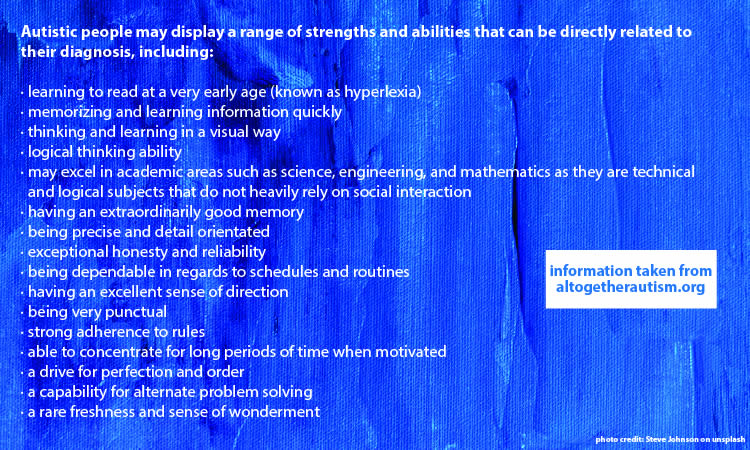
It is important to spread awareness about the strengths and challenges of those with autism. But I also believe sharing the experiences of two young women with ASD will help all of us better understand that despite the challenges they face, they have much to offer our world.
Early Intervention

Two-year old Kai is just precious!
Kai’s mom, Denise, graciously agreed to share Kai’s journey with me.
Early intervention for Kai began when she was six months old. By seventeen months, Denise knew Kai fell on the autism spectrum: “I absolutely knew when I walked into the room, and she was rocking on her back and watching TV upside down.”
Kai’s official diagnosis came at twenty-six months. By that time, Kai received early intervention services that included applied behavioral analysis, occupational therapy, physical therapy, and speech therapy.
Long Road Ahead
“Kai’s father and I separated during her year in Kindergarten. I didn’t know if I would have to care for her all alone. It felt like a long road ahead. ” Denise shared.
During Kindergarten and first grade, Kai received special education services, which also included music therapy, occupational therapy, and speech services. She repeated first grade to give her the opportunity to connect with students who were a year younger and closer to her emotional level.
Denise welcomed the recommendation for inclusion with her non-disabled peers in second grade. Kai struggled academically that year, because anxiety overwhelmed her. A less inclusive classroom with a focus on life skills instruction made up Kai’s third grade year.
Fifth grade was a hard year for Kai as her peers moved up and she didn’t. She struggled with anger, but medication helped her manage her emotions.
Loves to Make Others Laugh
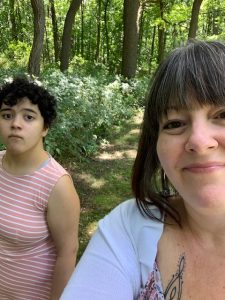
Kai with her mom, Denise
IQ and academic testing at age thirteen revealed Kai performs at a second-grade level. Academically, Kai may not be performing at the same level as her peers, but her strengths allow her to make social connections with peers and contribute to the group.
Kai connects well with others. She is a rule follower, polite, and has good manners. Independently taking her medication demonstrates her desire for self-care. Her favorite activity, cooking, gives her the opportunity to take care of others. Humor is one of Kai’s strengths as she loves to make others laugh.
At thirteen, Kai developed epilepsy. Medication continues to help reduce the number of seizures she has each month.
Help Her Be Semi-Independent

Kai showing her overcomer O
Kai experiences struggles with her senses in that she wants to chew and bite, so Denise always has ice and bowls of raw vegetables available for her. Lights and sounds overwhelm her at times.
In high school, Kai’s curriculum consists of some academics, as well as cooking, sewing, learning to navigate the grocery store, and how to send/receive emails. Denise shared, “Kai will not receive a high school diploma, but her vocational training will help her be semi-independent when she ages out of special education services.”
Kai is sixteen years old. Denise hopes Kai’s skills continue to strengthen, so she can hold a job, use public transportation, and live more independently with her same-age peers when she is a young adult.
Socially Anxious and Uncomfortable
Hannah, a twenty-year old college student, has a different journey than Kai.
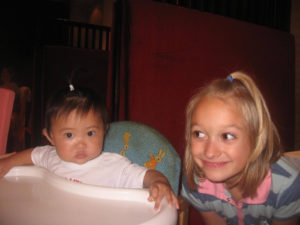
Hannah (right) with her sister
“I always felt something was wrong with me, but I didn’t know what it was,” Hannah shared at the beginning of her interview.
She discussed the struggles she experienced as a child before her diagnosis at seventeen years old. “I was socially anxious and uncomfortable around people. I liked the stability of true friends, but I shut down when my best friend would force me to play what she wanted to play. All her talking overloaded my senses.”
She remembers kids not being nice to her, but she believes it may have been anxiety that made her feel that way.
Processing Sensory Information
Processing sensory information was challenging and overwhelming for Hannah. For example, the texture of applesauce, grits, and unfinished wood made her extremely uncomfortable. When she was a baby, having socks on her feet would make her cry so hard she would throw up. A seat belt felt overly restricting.
When she was younger, Hannah felt uncomfortable with physical touch. (And sometimes does even now) The roar of music and cheering at her sister’s cheer leading competition overloaded her senses, causing her to cry. When she’s feeling tired, Hannah notices lights can cause migraines.
On the days her senses overwhelm her, her brain and her body shut down. She finds being alone helps.
Might Be Autistic
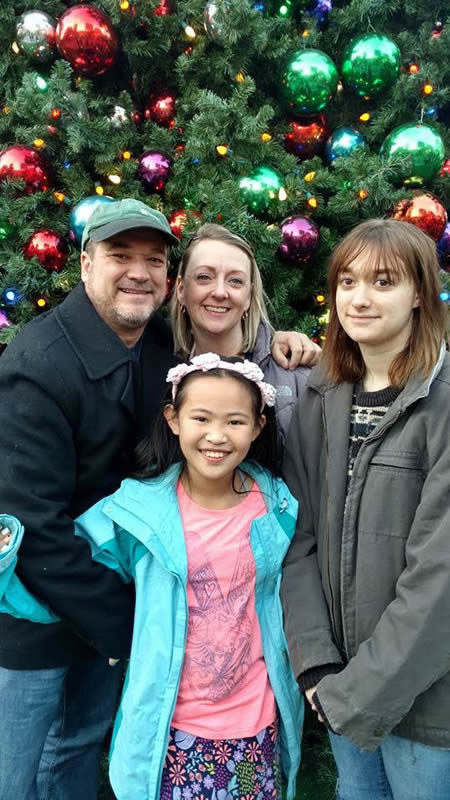
Hannah (17 yo) with her family
A turning point in Hannah’s journey occurred when her mom’s friend suggested that Hannah might be autistic. Hannah was seventeen years old at the time. Researching autism and joining an online autism community helped her discover that she was autistic.
The results of a psychological evaluation did not confirm Hannah’s self-diagnosis. The psychologist diagnosed Hannah with anxiety, depression, and avoidant personality disorder. Both Hannah and her parents disagreed with the avoidant personality disorder diagnosis. “I didn’t hate people. I just hated the way people made me feel,” Hannah shared.
Hannah took action. “I wrote a three page list of reasons why that diagnosis was wrong.” The psychologist agreed with Hannah’s reasoning and changed the diagnosis to ASD.
“That was a good step, because I felt relieved. The autism diagnosis helped me to understand why I was different than others.”
ASD Diagnosis Opened the Door
Hannah’s ASD diagnosis opened the door to accommodations that would help her be successful in college. One such accommodation allowed Hannah to have a private dorm room. “I wouldn’t have done well with a roommate, and I wouldn’t have been able to function. It would have been so stressful,” she shared.
Hannah spends time in self-reflection to pinpoint potential problems that are related to ASD. “I come up with strategies that will help lessen how social situations will impact me. If I’m going somewhere with a large number of people, I take my anxiety medication and know the way out. I usually bring along a safe person, too.”

Hannah showing her overcomer O
Because of not being understood for many years, Hannah started college with low self-esteem and low self-confidence. As she built and maintained friendships, things began changing. Currently, she is pursuing a degree in history with the hopes of earning a master’s degree in library science. She may even become a college professor. Because she’s making progress on her goals, she feels her anxiety is lessening and her confidence is growing. “My younger self would be so proud of me,” she shares with a big smile.
Hannah has learned that “overcoming is acceptance. You must accept your circumstances. Only through acceptance can you overcome.”

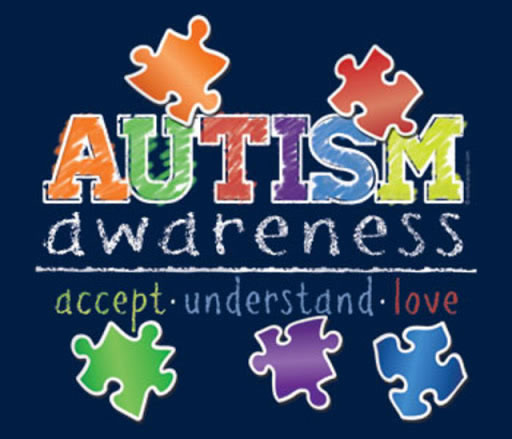
Both of these young women are extraordinary! Thank you for shedding some light on ASD and how it affects different people, well… differently. It is so true the saying “if you’ve met one person with autism, you have met one person with autism.” It is a broad spectrum indeed. Bless you!
Way to go Hannah
Powerful stories – thank you for speaking out and advocating!! Powerful to see the journey- thank you for sharing
A wonderful article about a great family! Denise is a great mom with awesome kids!
Denise Bains ❤️❤️ We love you so much and Kai Kai is especially blessed to have you as her Mother. ❤️❤️❤️❤️
Great stories. My son was diagnosed at age 36 with Asperger’s which is no longer a stand alone diagnosis. It now falls under the spectrum of Autism, although the higher functioning end of the spectrum. In retrospect, I can now see that some of the traits I thought were shyness were likely indicators of his condition. Back in the 80’s, there was not a lot of information about Asperger’s. Even today, it is hard to find info about adult Asperger’s.